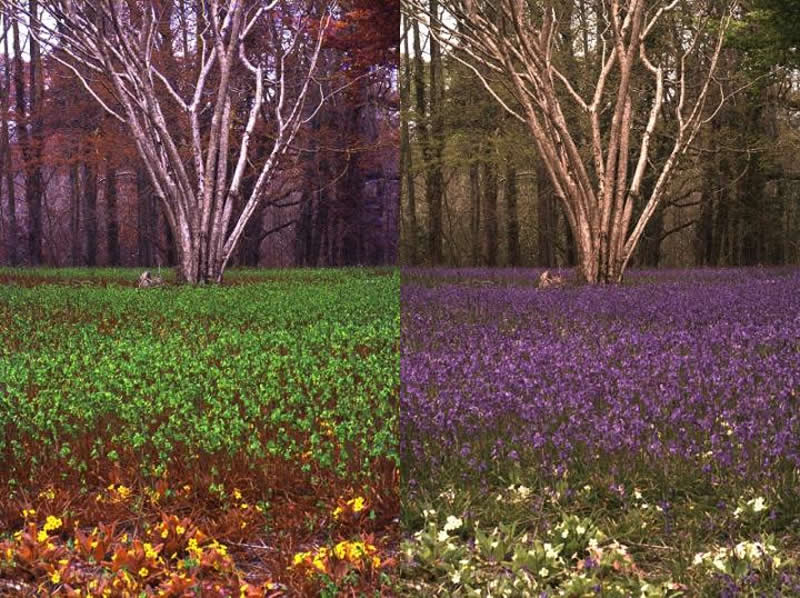Summary: New computer software sheds light on animal visual processing and perception.
Source: University of Queensland
Humans are now closer to seeing through the eyes of animals, thanks to an innovative software framework developed by researchers from the University of Queensland and the University of Exeter.
PhD candidate Cedric van den Berg from UQ’s School of Biological Sciences said that, until now, it has been difficult to understand how animals really saw the world.
“Most animals have completely different visual systems to humans, so – for many species – it is unclear how they see complex visual information or colour patterns in nature, and how this drives their behaviour,” he said.
“The Quantitative Colour Pattern Analysis (QCPA) framework is a collection of innovative digital image processing techniques and analytical tools designed to solve this problem.
“Collectively, these tools greatly improve our ability to analyse complex visual information through the eyes of animals.”
Dr Jolyon Troscianko the study’s co-leader from the University of Exeter said colour patterns have been key to understanding many fundamental evolutionary problems, such as how animals signal to each other or hide from predators.
“We have known for many years that understanding animal vision and signalling depends on combining colour and pattern information, but the available techniques were near impossible to implement without some key advances we developed for this framework.”
The framework’s use of digital photos means it can be used in almost any habitat – even underwater – using anything from off-the-shelf cameras to sophsiticated full-spectrum imaging systems.
“You can even access most of its capabilities by using a cheap (~ $110 AUD, £60 GBP, $80 USD) smartphone to capture photos,” Dr Troscianko said.
It took four years to develop and test the technology, which included the development of an extensive interactive online platform to provide researchers, teachers and students with user-guides, tutorials and worked examples of how to use the tools.
UQ’s Dr Karen Cheney said the framework can be applied to a wide range of environmental conditions and visual systems.

“The flexibility of the framework allows researchers to investigate the color patterns and natural surroundings of a wide range of organisms, such as insects, birds, fish and flowering plants,” she said.
“For example, we can now truly understand the impacts of coral bleaching for camouflaged reef creatures in a new and informative way.”
“We’re helping people – wherever they are – to cross the boundaries between human and animal visual perception.”
“It’s really a platform that anyone can build on, so we’re keen to see what future breakthroughs are ahead.”
Source:
University of Queensland
Media Contacts:
Cedric van den Berg – University of Queensland
Image Source:
The images are credited to Jolyon Troscianko.
Original Research: Open access
“Quantitative Colour Pattern Analysis (QCPA): A comprehensive framework for the analysis of colour patterns in nature”. Cedric P. van den Berg, Jolyon Troscianko, John A. Endler, N. Justin Marshall, Karen L. Cheney.
Methods in Ecology and Evolution doi:10.1111/2041-210X.13328.
Abstract
Quantitative Colour Pattern Analysis (QCPA): A comprehensive framework for the analysis of colour patterns in nature
To understand the function of colour signals in nature, we require robust quantitative analytical frameworks to enable us to estimate how animal and plant colour patterns appear against their natural background as viewed by ecologically relevant species. Due to the quantitative limitations of existing methods, colour and pattern are rarely analysed in conjunction with one another, despite a large body of literature and decades of research on the importance of spatio‐chromatic colour pattern analyses. Furthermore, key physiological limitations of animal visual systems such as spatial acuity, spectral sensitivities, photoreceptor abundances and receptor noise levels are rarely considered together in colour pattern analyses.
Here, we present a novel analytical framework, called the Quantitative Colour Pattern Analysis (QCPA). We have overcome many quantitative and qualitative limitations of existing colour pattern analyses by combining calibrated digital photography and visual modelling. We have integrated and updated existing spatio‐chromatic colour pattern analyses, including adjacency, visual contrast and boundary strength analysis, to be implemented using calibrated digital photography through the Multispectral Image Analysis and Calibration (MICA) Toolbox.
This combination of calibrated photography and spatio‐chromatic colour pattern analyses is enabled by the inclusion of psychophysical colour and luminance discrimination thresholds for image segmentation, which we call ‘Receptor Noise Limited Clustering’, used here for the first time. Furthermore, QCPA provides a novel psycho‐physiological approach to the modelling of spatial acuity using convolution in the spatial or frequency domains, followed by ‘Receptor Noise Limited Ranked Filtering’ to eliminate intermediate edge artefacts and recover sharp boundaries following smoothing. We also present a new type of colour pattern analysis, the ‘local edge intensity analysis’ as well as a range of novel psycho‐physiological approaches to the visualization of spatio‐chromatic data.
QCPA combines novel and existing pattern analysis frameworks into what we hope is a unified, free and open source toolbox and introduces a range of novel analytical and data‐visualization approaches. These analyses and tools have been seamlessly integrated into the MICA toolbox providing a dynamic and user‐friendly workflow.






